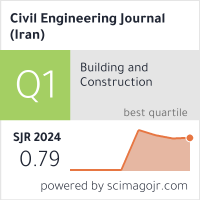BIM as Evaluation Tool for Existing Building Energy and Quantities Takeoff
Downloads
Information technology and its application have resulted in enormous development in the construction industry during the last decade. The main reason behind this evolution was the incorporation of Building Information Modeling (BIM) to be an inefficient construction approach. BIM is now globally considered to be the tool of transforming the construction process to new era. It is also considered as a good tool for the whole project lifecycle. The aim of the present study is to clarify how BIM can be used in after project construction within uncertainty and risky environment such as document losses and unrecorded change orders. Interviews with project team, project site photography, collecting the available schemes and documents were the approaches used in this work to re-build the projects models. The results obtained from this work show that the knowledge and expectations of BIM within existing building have an admirable achievements for construction industry. Furthermore, BIM approach used in this work made more progress in the implementation of BIM as a rehabilitation and renovation tool in civil projects. The conclusions from this study reflect high correlation between the quantities take off with what as-built constructed, more than the traditional approach. The glamorous lessons derived from BIM implementation for the case study is; working with a model in which all project team feel comfortable and harmonic, will ensure enough resources to make the model updated and ought to lead to a minimum conflict within the model or what traditionally called "project documents”.
Downloads
[2] Eastman, C. Teicholz, P. Sacks R., Liston, K. (2008). "BIM Handbook: A guide to BIM for Owners”, Managers, Designers, Engineers and Contractors, Wiley publication, ISBN 978-0-470-18528-5.
[3] B. Gerber, F. Jazizadeh, N. Li, and G. Calis, "Application areas and data requirements for BIM enabled facilities management," Journal of construction engineering and management, vol. 138, pp. 431-442, 2011. DOI: 10.1061/(ASCE)CO.1943-7862.0000433
[4] L, P. Irani, Z. Edwards D. A Rework Reduction Model for Construction Projects IEEE transactions on engineering management, Vol 51 No 4 Nov 2004. DOI: 10.1109/TEM.2004.835092
[5] S.Mohammad Abd, A. Mahde Abd, MFM Zain and Amiruddin Ismail. 2008. Development of productivity assessment methodology for concreting process. ARPN Journal of Engineering and Applied Sciences. 3(5): 1-7. http://www.arpnjournals.com/jeas/research_papers/rp_2008/jeas_1008_122.pdf
[6] Van Wagenen, Haley West (2012). Building Information Modeling and Historic Buildings: How a Living Model Leads to Better Stewardship of the Past. (Master Thesis). University of Pennsylvania, USA.
[7] PA.Jawadekar, Salil. A Case Study of the Use of BIM and Construction Operations Building Information Exchange (COBie) for Facility Management. Diss. Texas A & M University, 2012." https://repository.upenn.edu/hp_theses/197/
[8] Brandon, P. (2011) Sharing Intelligence: The problem of knowledge atrophy, Chapter 4, Distributed intelligence in design, Wiley Blackwell, ISBN 978-1-4443-3338-1.
[9] Blanch, Jessica Maureen. 2012. Building Community, Building Capacity: Revitalization through Reuse. (Master Thesis). University of Washington, USA."
[10]. Mattsson, Martin, and Mathias Rodny. "BIM in Infrastructure: Using BIM to increase efficiency through the elimination of wasteful activities. (Master Thesis) Royal Institute of Technology (KTH) Stockholm, Sweden 2013."
[11]. Lindblad, H. Study of the implementation process of BIM in construction projects/analysis of the barriers limiting BIM adoption in the AEC-industry. (Master Thesis) Royal Institute of Technology (KTH) Stockholm, Sweden 2013."
[12] N. Nazar, Using the virtual building technology for quantity surveying of buildings. (Master Thesis), University of Baghdad 2014.
[13] Panaitescu, R.M. Building Information Modeling: Towards a structured implementation process in an engineering organization. (2014), uuid:df3f4fdc-b86b-48df-ba3c-25a22c0002a2
[14] AbuHamra, Lina Ahmed, An Investigation into Building Information Modelling (BIM) Application in Architecture, Engineering and Construction (AEC) Industry in Gaza strip. (Master Thesis) IUG University, Palestine. Available at SSRN: https://ssrn.com/abstract=2701999
[15] Abbas M Abd, Alaa S Khamees. 2017. As built case studies for BIM as conflicts detection and documentation tool. Cogent Engineering. Vol. 4(1), Pp:1411865. https://doi.org/10.1080/23311916.2017.1411865
[16] Khaddaj, Maggie, and Issam Srour. (2016). Using BIM to retrofit existing buildings. Procedia Engineering, vol. 145, pp: 1526-1533." https://doi.org/10.1016/j.proeng.2016.04.192
[17] Gourlis, Georgios, and Iva Kovacic. A study on building performance analysis for energy retrofit of existing industrial facilities. Applied Energy 184 (2016): 1389-1399." https://doi.org/10.1016/j.apenergy.2016.03.104
[18] Abbas M. Abd, Suhad M Abd. (2012). Resources sustainability planning model using hierarchical approach for construction project. (DJES) Diyala journal for Engineering Sciences. Vol. 5(02): pp. 1-19.
- Authors retain all copyrights. It is noticeable that authors will not be forced to sign any copyright transfer agreements.
- This work (including HTML and PDF Files) is licensed under a Creative Commons Attribution 4.0 International License.![]()















